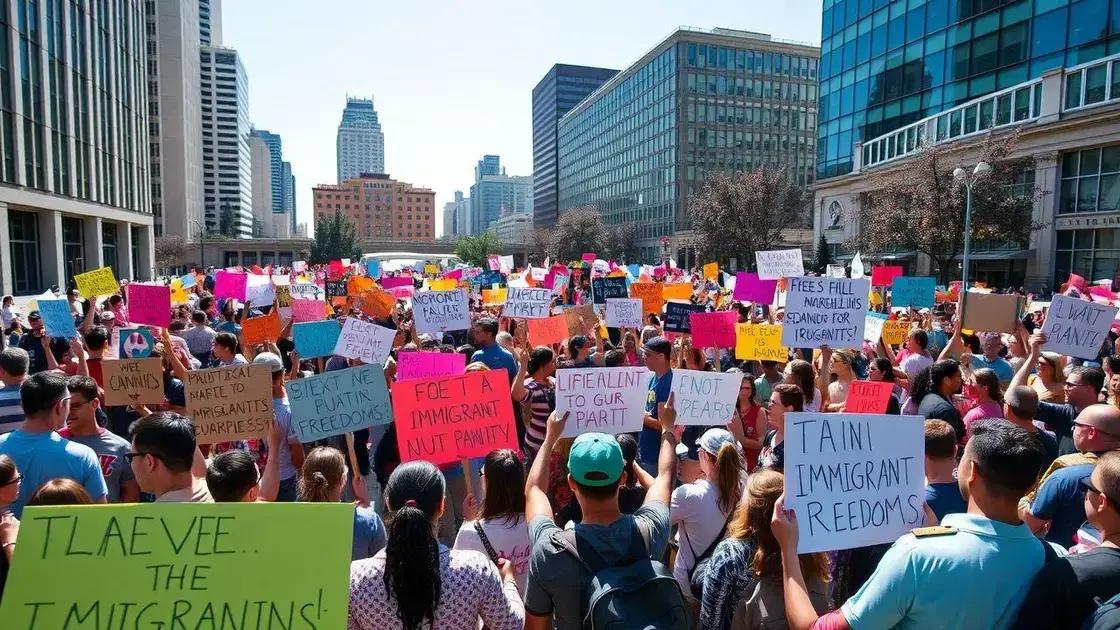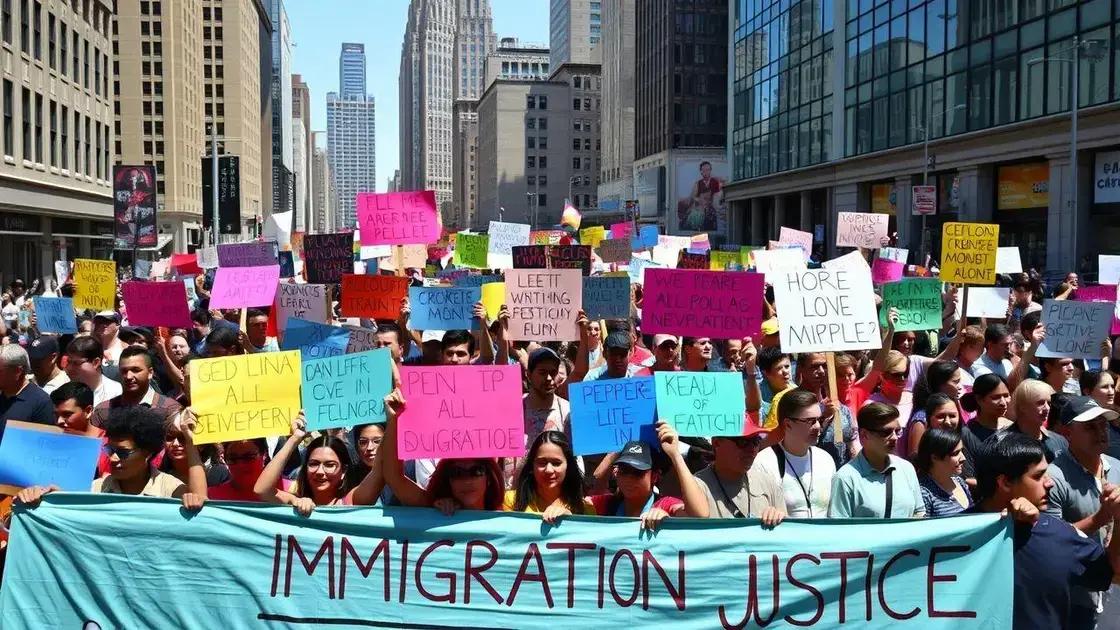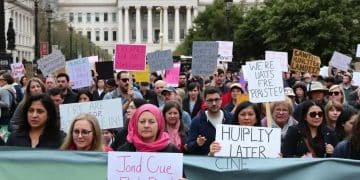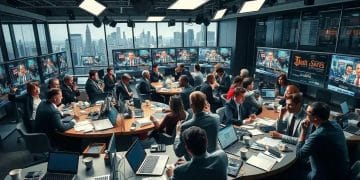Immigration rights demonstrations escalate in April 2025

Immigration rights demonstrations in April 2025 are driven by community stories, advocate efforts, and youth engagement, all demanding urgent reforms to respect human rights and address family separations.
Immigration rights demonstrations escalate in April 2025, marking a significant moment in the ongoing debate about immigration policies. What are the factors driving this change, and how might it affect future laws? Let’s delve into the details.
Overview of April 2025 demonstrations
The April 2025 demonstrations have emerged as a pivotal moment in the landscape of immigration rights. With thousands taking to the streets, the movement has gained momentum, pushing for immediate changes in policies.
The Spark of Change
Several factors contributed to the escalation of these protests. The community is united by a common cause, demanding fair treatment and policies that respect human rights.
Reasons Behind the Demonstrations
- Increased deportation rates and their impacts on families.
- The push for a pathway to citizenship for undocumented immigrants.
- Rising public awareness and support for immigrant rights.
- Grassroots organizing and mobilization efforts across cities.
As individuals rally together, the media coverage amplifies their voices, showcasing personal stories that resonate with many. By highlighting the plight of immigrant families, the demonstrations not only aim to influence policy but also strive to change public perception. The participants include various demographics, demonstrating a united front in the fight for equality.
Moreover, social media plays a critical role, allowing each protestor to share their experiences and connect with a broader audience. The use of hashtags and live updates keeps the conversation alive while inspiring others to join the cause. This digital engagement has the potential to mobilize even more supporters.
Throughout April, these demonstrations have not only shaped discussions but have also empowered numerous voices that have long been silenced. The increasing visibility of immigrant rights issues draws attention to the urgent need for reform. As more people join the conversations, communities forge stronger bonds, creating a resilient network of support.
Key reasons behind the surge

The surge in immigration rights demonstrations can be attributed to several key factors that resonate deeply within communities. As more individuals face challenges related to immigration policies, these reasons help explain the growing urgency among protestors.
Major Contributors to the Movement
First, there has been an uptick in deportations affecting families. As loved ones are separated, the community’s outcry becomes louder. This personal impact fuels the passion of those fighting for change.
Grassroots Organization and Mobilization
- Activists are leveraging social media to share stories and mobilize supporters.
- Local community organizations have intensified their efforts to educate and empower immigrants.
- Fundraising for legal aid is becoming essential in combating unjust practices.
- Collaborative events draw diverse groups together, amplifying their collective voice.
Another crucial factor is the shift in public opinion. More people are recognizing the importance of immigration rights, which helps to normalize the discussions around these topics. As awareness spreads, more allies join the cause, providing additional support.
Additionally, families affected by immigration issues are brave enough to share their stories. These personal narratives humanize the subject, ensuring that it remains at the forefront of conversations. The varied backgrounds of protestors create a rich tapestry contributing to a unified message: everyone deserves respect and fair treatment.
Moreover, many young people are at the forefront of these movements, bringing energy and innovative tactics to the protests. Their willingness to stand up and speak out has reinvigorated the fight for immigration rights. These young demonstrators understand the stakes and are determined to effect change.
Impact on immigration policy discussions
The impact of recent demonstrations on immigration policy discussions has been significant. As protestors demand change, lawmakers are feeling the pressure to respond. These events are shaping the way people view immigration laws and their effectiveness.
Shifting Perspectives
For many policymakers, the demonstrations serve as a wake-up call. They reveal the emotional toll that aggressive immigration policies have on families and communities. Affected individuals are sharing their experiences, prompting legislators to reconsider their positions.
Key Changes in Discussions
- Policies aimed at deportation are being openly challenged.
- Conversations about creating pathways to citizenship are gaining traction.
- Increased focus on humanitarian aspects of immigration law.
- Proposals are being made to provide legal protections for vulnerable populations.
This shift lays a foundation for crucial reforms that prioritize justice and equality. As these discussions evolve, many advocates are hopeful for positive outcomes that reflect the needs of the community. With every protest, awareness spreads, fueling a dialogue that many believe is long overdue.
The participation of various groups also highlights how immigration issues intersect with broader social justice movements. Climate change, economic inequality, and human rights are all tied up in these conversations. By connecting these issues, the demonstrations are forcing a more comprehensive view of immigration, challenging simplistic narratives.
Moreover, media coverage of the protests brings them to a national audience. People are now more informed about the complexities of immigration policies and the urgent need for change. This exposure means that legislators cannot easily ignore the concerns of their constituents.
Voices from the protestors and community leaders

The voices from the protestors and community leaders play a crucial role in the ongoing movement for immigration rights. Their stories and perspectives not only inspire others but also highlight the real-life impacts of immigration policies.
Personal Stories of Impact
Many protestors share experiences about family separation and the fear of deportation. These narratives humanize the statistics and allow the public to connect on a personal level. Each story holds immense power, reminding people of the challenges faced by immigrant families.
Community Leaders Making a Difference
- Community leaders are often the backbone of this movement.
- They provide resources and support to families in need.
- Advocates work tirelessly to educate the public about immigration issues.
- Local organizations collaborate to amplify these voices.
Moreover, community leaders emphasize the importance of solidarity. They encourage diverse groups to unite in support of immigrant rights, creating a broader coalition for change. By bringing together different perspectives, the movement becomes more inclusive and impactful.
The presence of youth in these demonstrations adds a vital layer of energy. Young leaders articulate their dreams for a future without fear. They are passionate advocates, using social media to share their messages and inspire action among their peers.
As local leaders step up to represent their communities, their dedication shines through. They articulate the need for just policies and demand respect for all. This ongoing dialogue fosters understanding and compassion as more people join the fight for change.
immigration rights have sparked vital conversations across communities and among leaders. The powerful stories and voices of protestors and advocates push for necessary changes. As discussions progress, there is hope for a future where immigration policies reflect fairness and respect for all individuals, regardless of their background. Together, the movement continues to build momentum, urging everyone to stand united for justice and equality.
FAQ – Frequently Asked Questions about Immigration Rights Demonstrations
What is the main goal of the immigration rights demonstrations?
The main goal is to advocate for fair treatment and necessary reforms in immigration policies that respect human rights.
How can personal stories from protestors impact the movement?
Personal stories humanize the issues, making it easier for the public and lawmakers to understand the real-life effects of immigration policies.
Who are the key leaders in the immigration rights movement?
Key leaders include community organizers, activists, and local figures who work tirelessly to support and educate families affected by immigration issues.
What role do young people play in these demonstrations?
Young people bring energy and creativity, often using social media to mobilize support and spread awareness about immigration rights.






